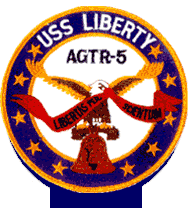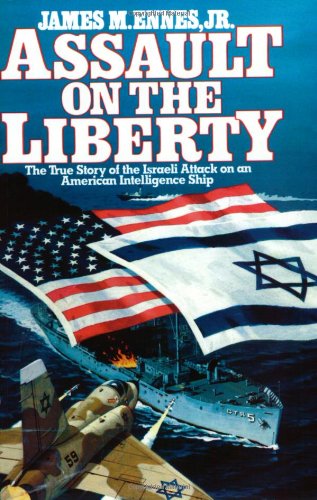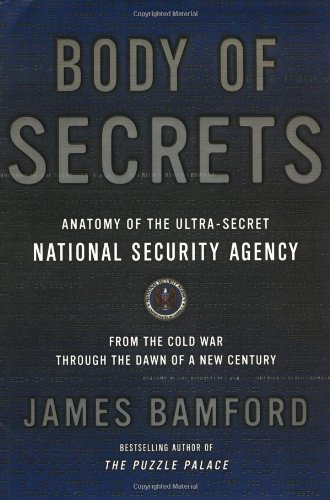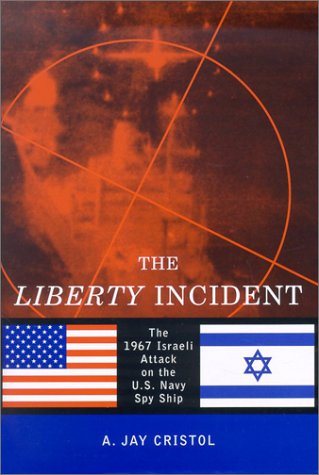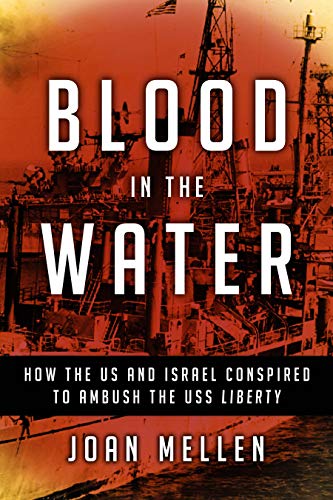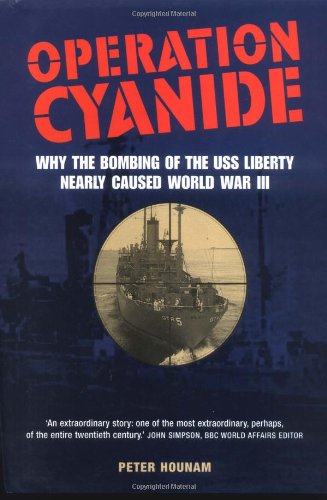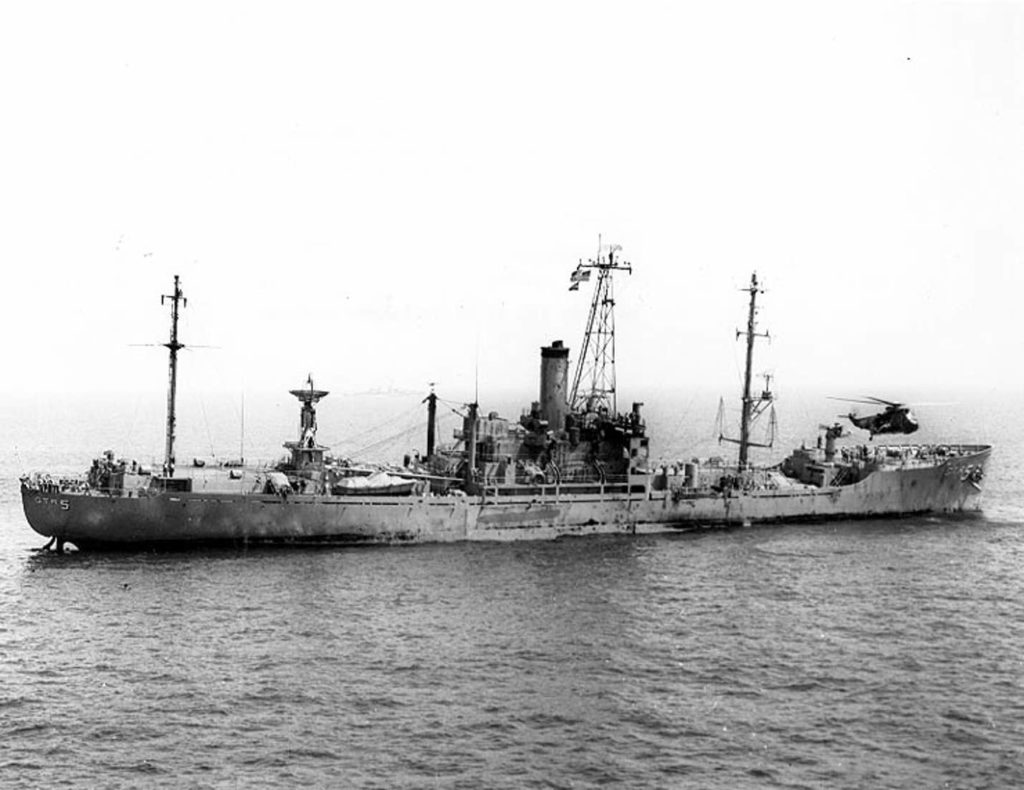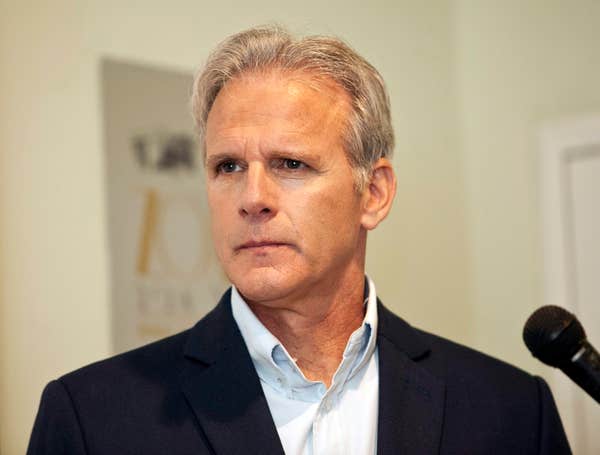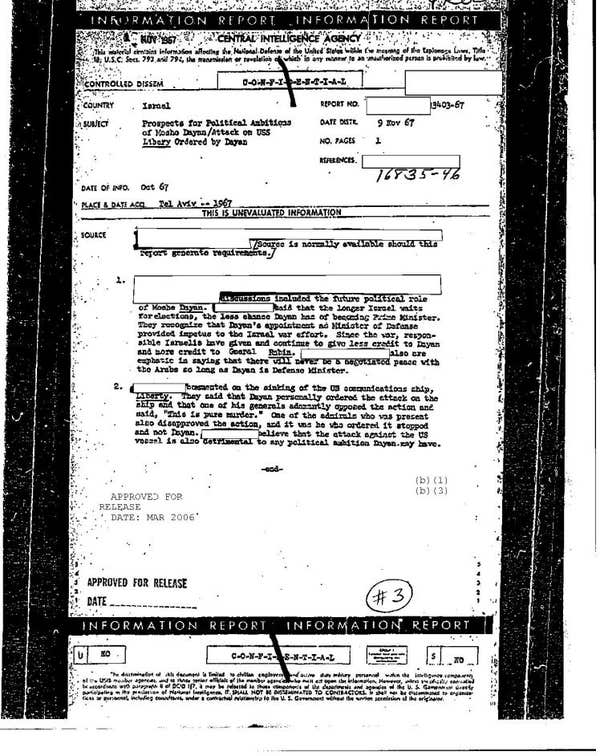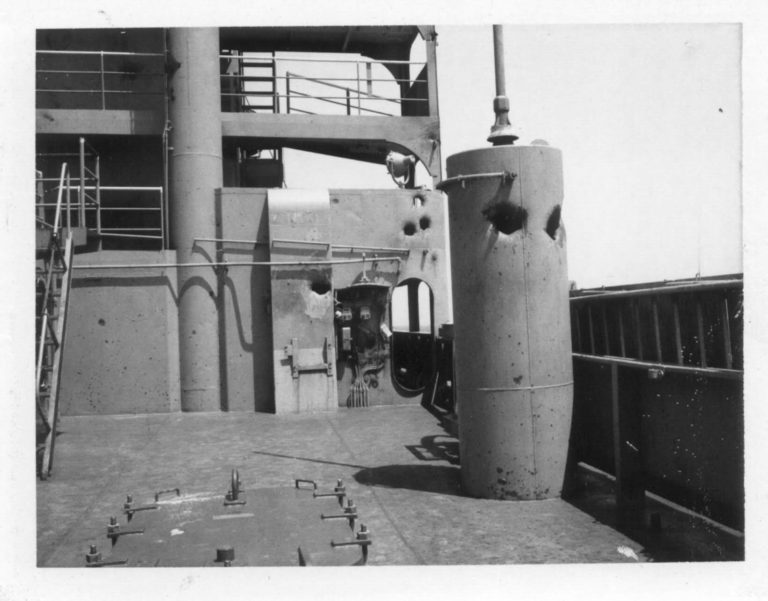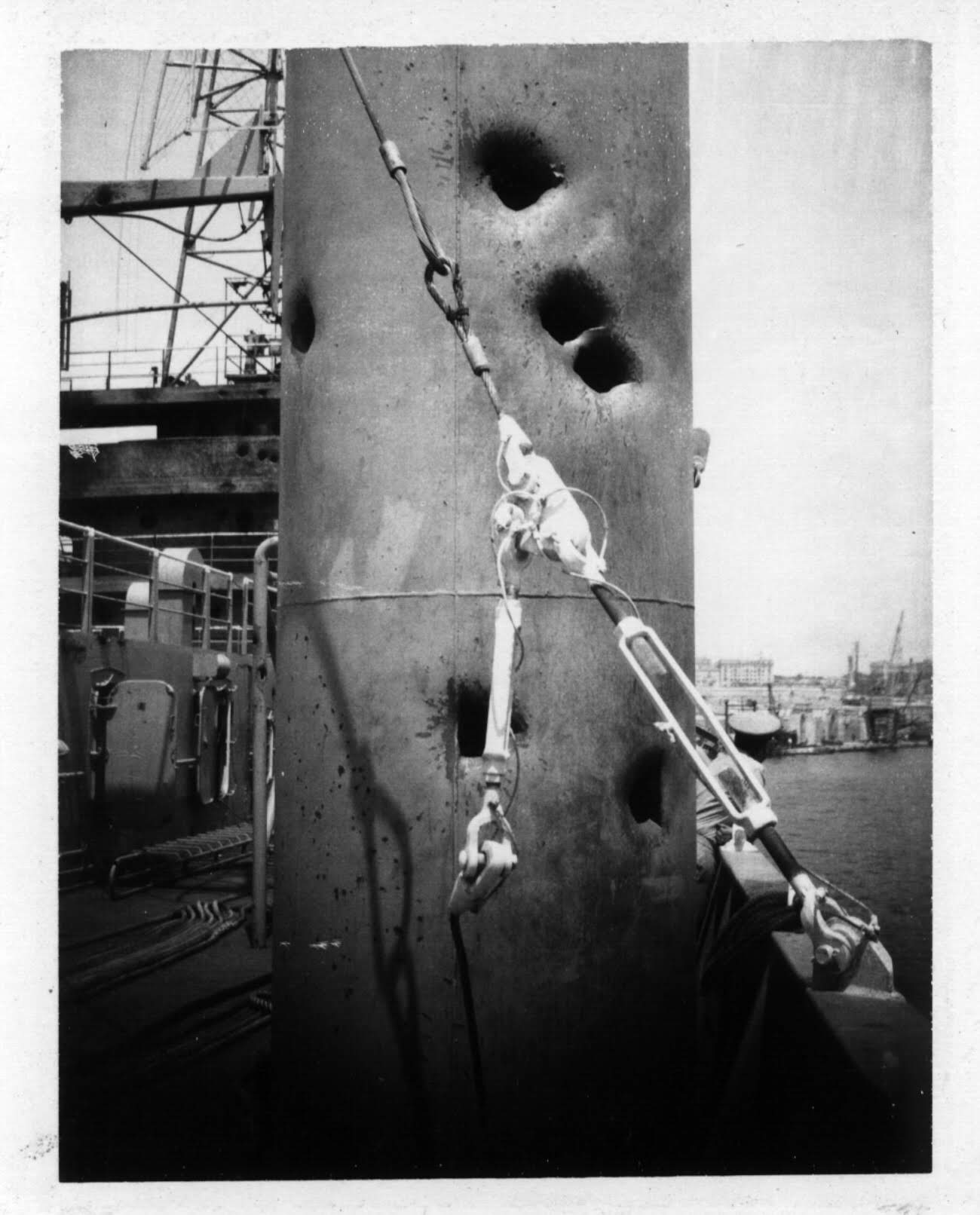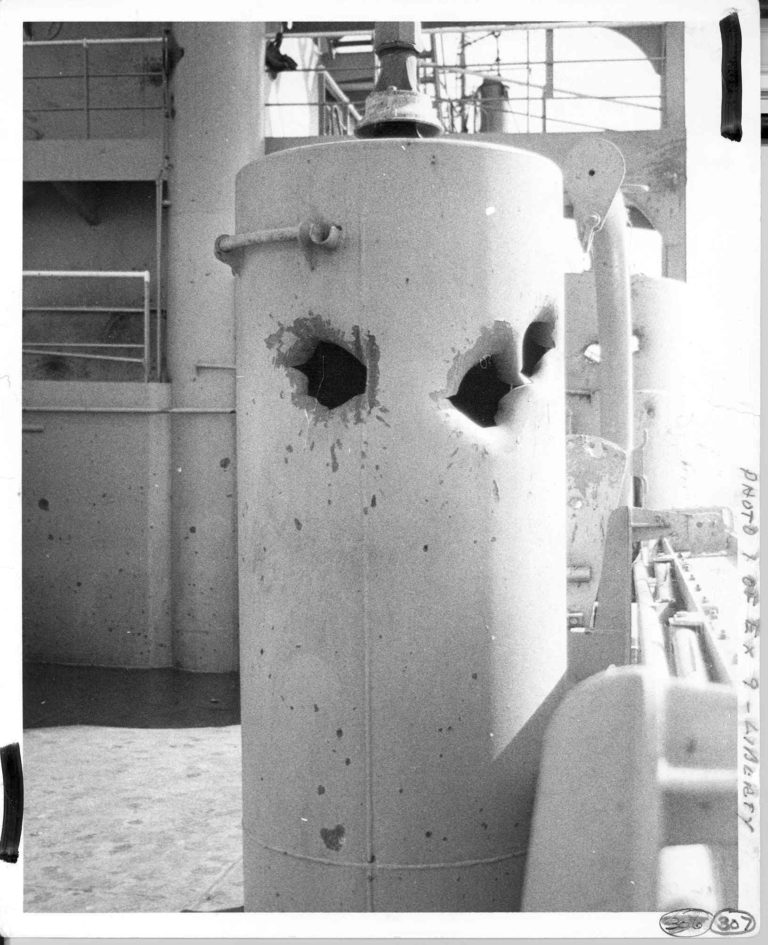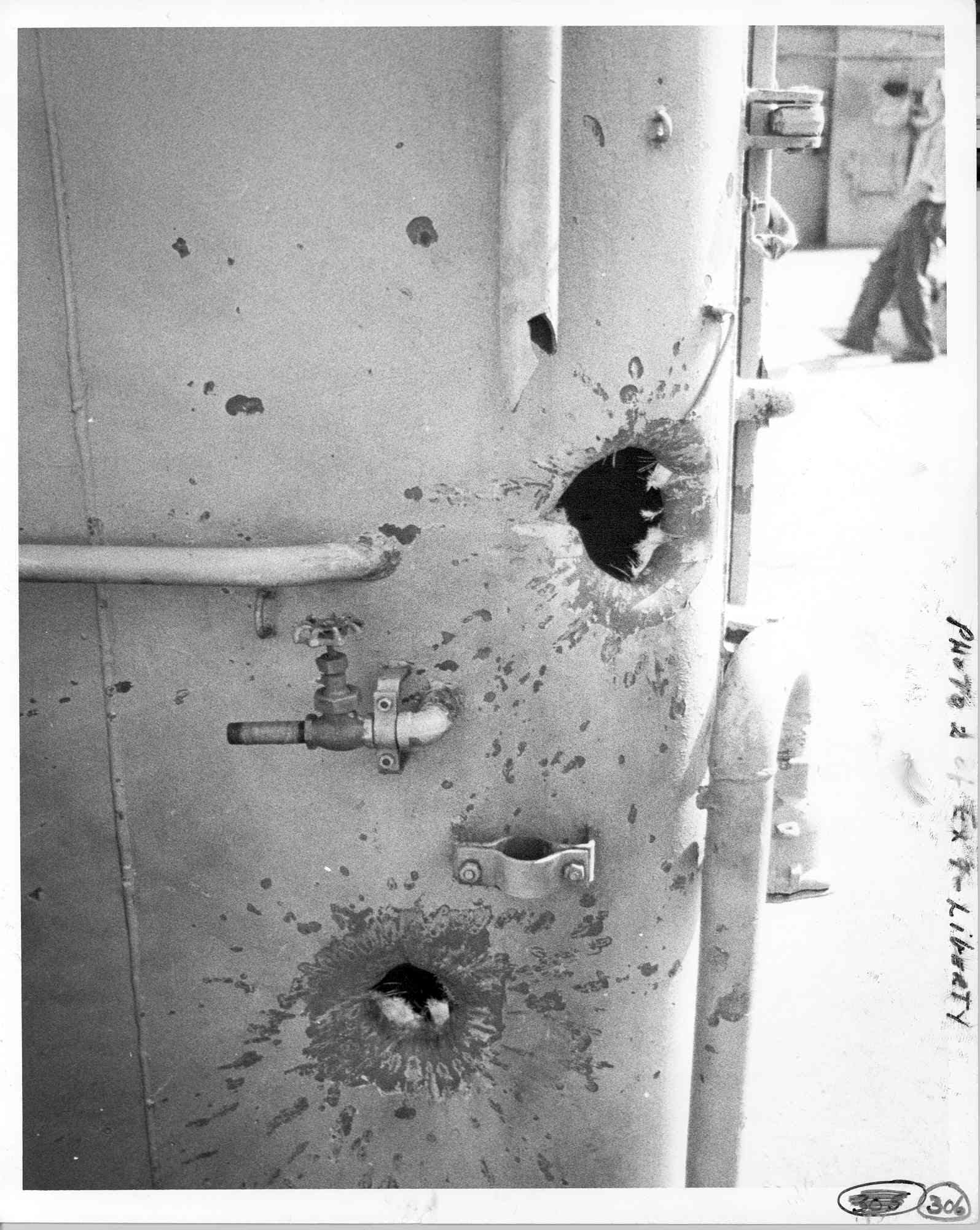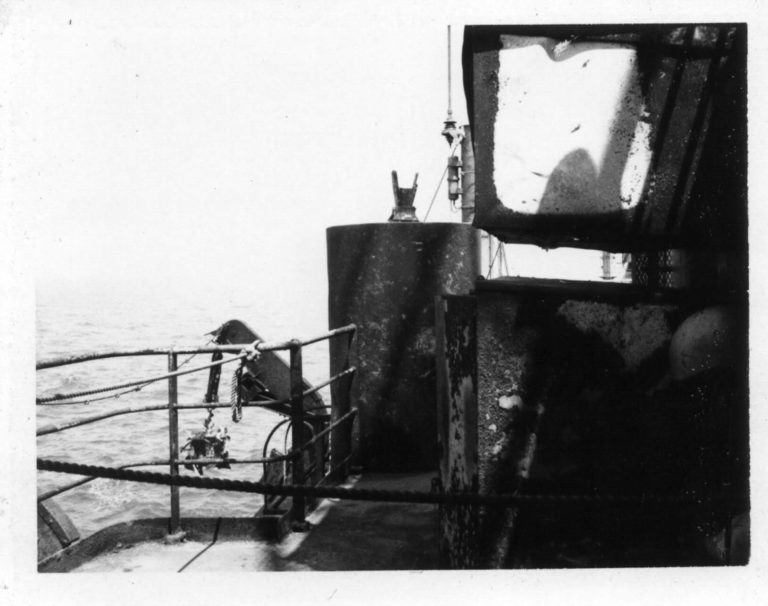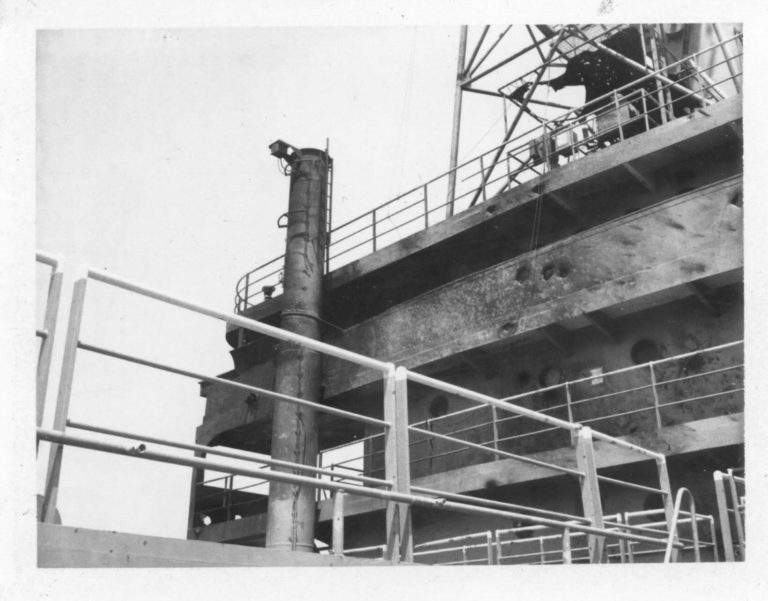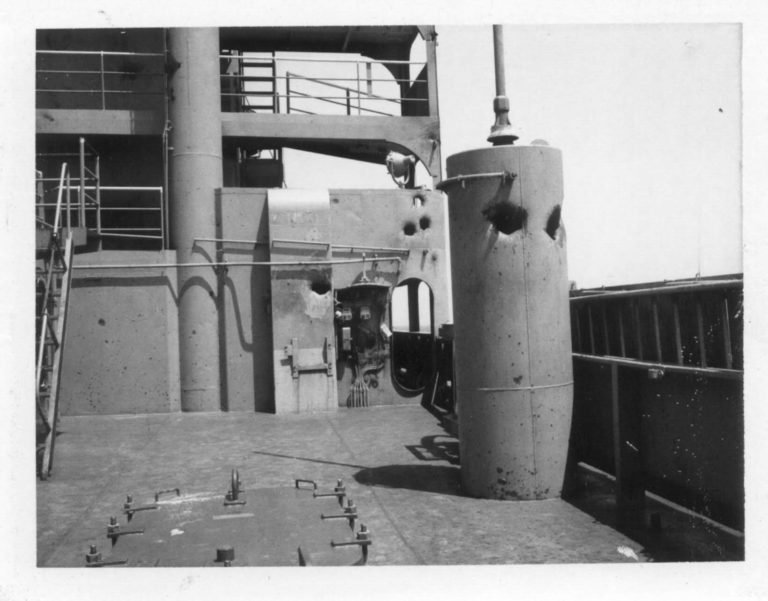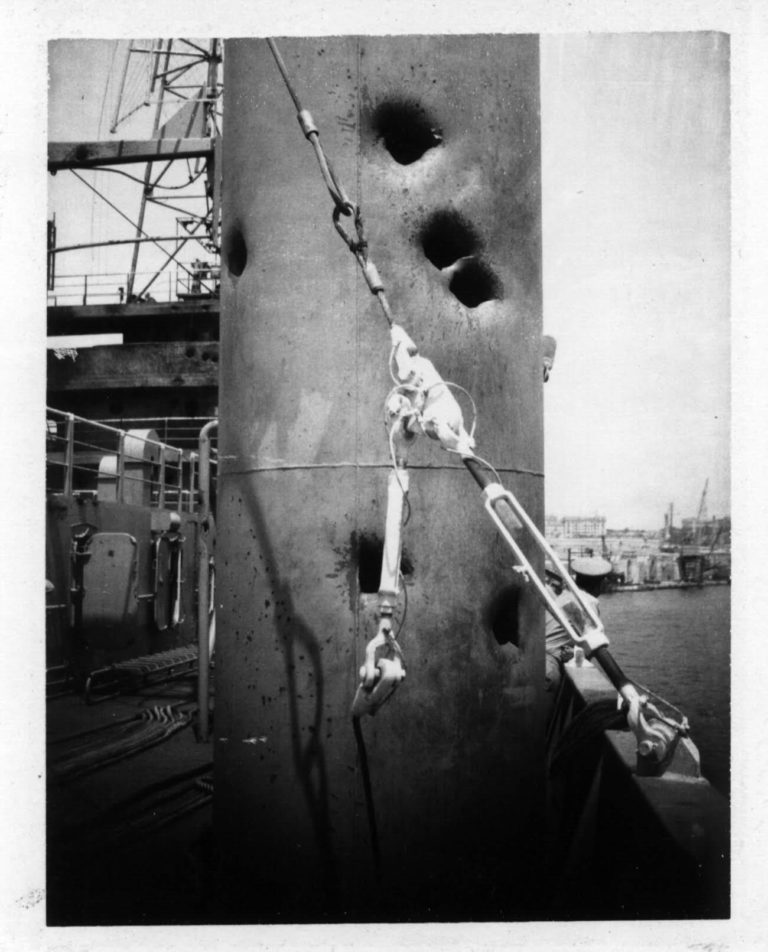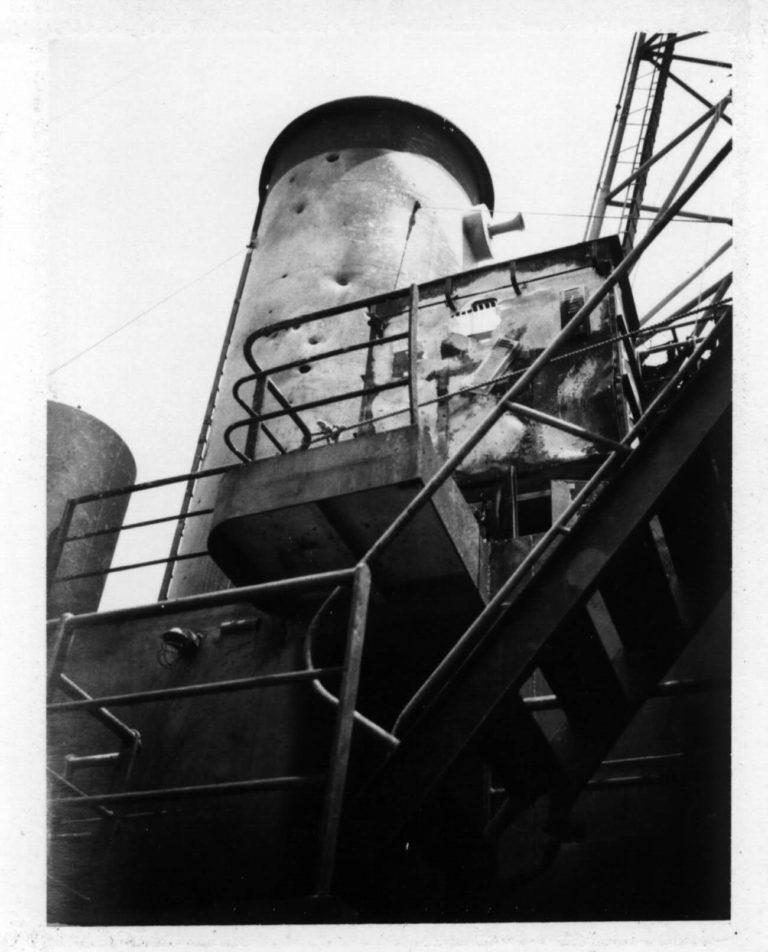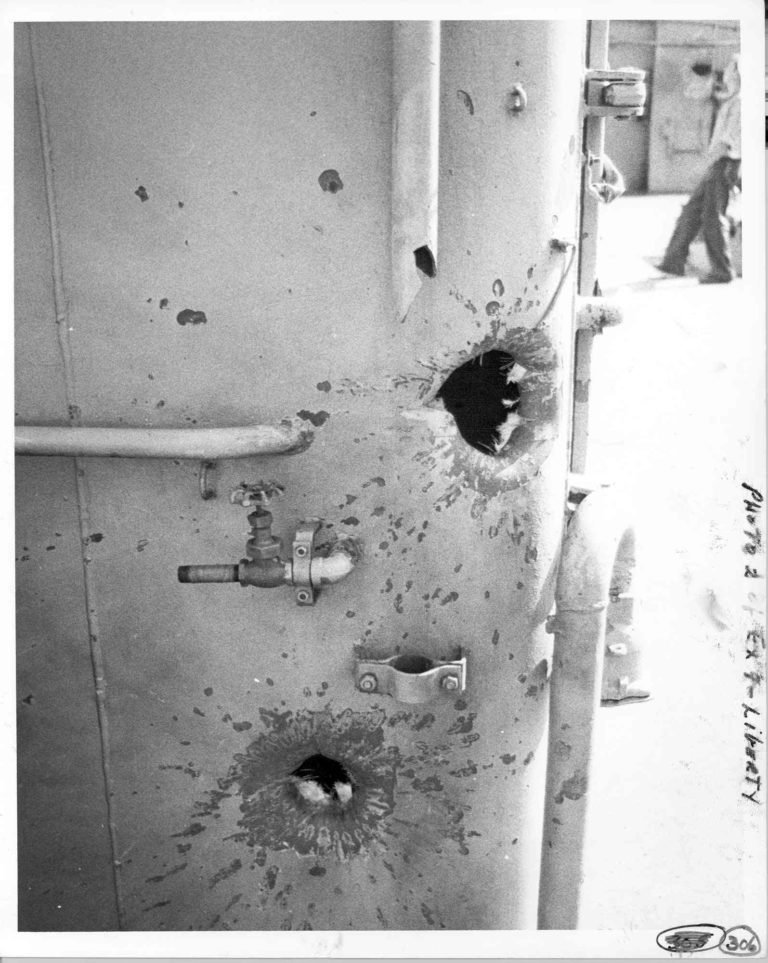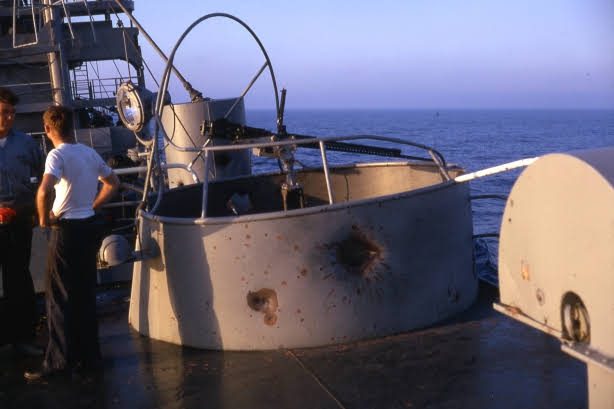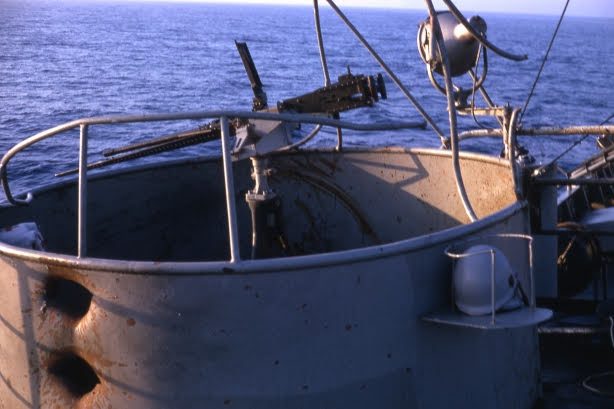Remembering the Liberty
by Ron Unz
Republished with Permission from the author
Concealing the Deliberate Israeli Attack
I’m not exactly sure when I first heard of the Liberty incident of 1967. The story was certainly a dramatic one, the attack upon an almost defenseless American intelligence ship by Israel’s air and naval forces late in the Six Day War fought against several Arab states. Over 200 American servicemen were killed or wounded by Israeli machine-guns, rockets, napalm, and torpedoes, representing our greatest naval loss of life since World War II. Only tremendous luck and the heroic actions of the sailors prevented the Liberty from being sunk with all hands lost.
The Israeli government quickly claimed that the attack had been accidental, a consequence of mistaken identification and the fog of war, but none of the survivors ever believed that story, nor did many of America’s top political and military leaders, notably Secretary of State Dean Rusk, CIA Director Richard Helms, and numerous top officers, including a later Chairman of the Joint Chiefs of Staff.
The real-life events of that day almost seem like a script out of Hollywood. The first wave of unmarked attacking jets had targeted and destroyed all of the Liberty‘s regular transmission antennas while also trying to jam all standard American broadcast frequencies to prevent any calls for help. A flotilla of torpedo boats later machine-gunned the life-rafts to ensure there would be no survivors. These relentless attacks lasted for more than an hour and completely perforated the vessel, with the sides and the decks being pitted by more than 800 holes larger than a man’s fist, including 100 rocket-hits that were six to eight inches wide, and a 40 foot hole below the waterline produced by a torpedo strike. Only a miracle kept the ship afloat.
This story combined so many elements of exceptional military heroism, political treachery, and success against all odds that if the Liberty had been attacked by any nation on earth except Israel, the inspirational events of June 8, 1967 might have become the basis for several big-budget, Oscar-nominated movies as well as a regular staple of television documentaries. Such a patriotic narrative would have provided very welcome relief from the concurrent military disaster our country was then facing in its Vietnam War debacle. But events involving serious misdeeds of the Jewish State are hardly viewed with great favor by the leading lights of our entertainment industry, and the story of the Liberty quickly vanished from sight so that today I doubt whether even one American in a hundred has ever heard of it.
Our news media has been almost as silent on the subject. In the immediate aftermath of the attack, there was naturally some coverage in our major newspapers and magazines, with several of the reports expressing considerable skepticism of the Israeli claims of having made an innocent mistake. But the Johnson Administration quickly imposed an extreme clampdown to suppress any challenges to the official story.
An American admiral soon met with all of the survivors in small groups, including the many dozens still hospitalized from their serious injuries, and he issued fearsome threats to those terrified young sailors, most of whom were still in their teens or early twenties. If any of them ever mentioned a word of what had happened—even to their mothers, fathers, or wives, let alone the media—they would immediately be court-martialed and end their lives in prison “or worse.”
With our journalists having great difficulty finding any eyewitnesses willing to talk and our government firmly declaring that the attack had been an unfortunate instance of accidental “friendly fire,” the newsmen quickly lost interest and the story faded from the headlines. Our government still remained so concerned about the smoldering embers of the incident that the surviving sailors were distributed across the other ships of our navy, apparently with efforts made to avoid having any of them serve together, which would have allowed them an opportunity to discuss the events they had barely survived.
The ensuing decade of the 1970s saw the Watergate Scandal unfold, culminating in the impeachment and resignation of a president, and numerous other sordid governmental scandals and abuses of power came to light in the years that followed, greatly eroding popular faith in the honesty of our government.
These changed circumstances helped provide an opening to James M. Ennes, Jr., one of the young surviving Liberty officers, who defied the threats of prosecution and imprisonment in order to reveal to the world what had happened.
Working closely with many of his fellow survivors, he spent years preparing a powerful manuscript and was introduced to a major publishing house by star New York Times reporter Neil Sheehan, who had written one of the earliest news accounts of the attack. His book Assault on the Liberty was released in 1979, producing the first major crack in the continuing wall of silence. Admiral Thomas Moorer, former Chairman of the Joint Chiefs of Staff, contributed a Foreword to a later edition, and the facts and gripping eyewitness testimony almost conclusively established that the Israeli attack had been entirely intentional. There were quite a number of favorable early reviews and interviews, leading to strong initial sales and further media coverage.
But organized pro-Israel groups soon counterattacked with a widespread campaign of suppression, working to prevent book sales and distribution while pressuring such influential television shows as ABC’s Good Morning America and CBS’s Sixty Minutes into canceling their planned segments. Successful books may sell tens of thousands of copies, but popular television programs reach tens of millions, so only a sliver of the American public ever learned the story of the Liberty. However, those who were politically aware and interested in the topic now had a solid reference source to cite and distribute, and the book also sparked the creation of the Liberty Veterans Association, which began to demand a reopening of the case and an honest investigation of what had happened that day.
The Israelis always claimed that the Liberty had been attacked because it was misidentified as a particular Egyptian naval vessel, and the official report of the American investigation had concurred. But Ennes’ book demolished that possibility.
(*) As America’s most advanced electronic surveillance ship, the Liberty had one of the most unique profiles in any navy, with its topside covered by an enormous array of different communications antennas, even including a 32-foot satellite-dish used to bounce signals off the Moon. By contrast, the Egyptian vessel was a decrepit old horse-transport just a fraction of the size, which was then rusting away in the port of Alexandria.
(*) By nearly all accounts, the air and naval forces deployed against the Liberty were completely unmarked, thus disguising their origins. None of the calls for help sent out mentioned the identity of the attackers, which the victims only discovered near the very end of the sustained engagement. If the Israeli forces had merely been striking against an assumed Egyptian military vessel, why would they have bothered to conceal their nationality?
(*) Despite repeated Israeli claims to the contrary, the Liberty had a large and very visible American flag flying at all times, and when the first one was shot down and destroyed early in the attack, an even larger Stars and Stripes was quickly hoisted as a replacement. The name of the ship was written in large English letters on its side, instead of the Arabic used by Egyptian vessels. The clear, bright weather that day provided perfect visibility.
(*) Israeli surveillance planes had repeatedly over-flown the Liberty all that morning, sometimes flying so low that the faces of the pilots could be seen, so the ship would have been easily identified.
(*) From the moment the attack began, Israeli electronic jamming had been employed to blanket all regular American communication channels, proving that the attackers knew the nationality of the ship they were targeting.
(*) The Israelis claimed that they initially assumed that the Liberty was a warship because it was traveling at a high speed of nearly 30 knots, but the ship’s speed during that entire period had merely been 5 knots, slower by a factor of six.
(*) The attack on the Liberty was a massive and coordinated action, lasting one to two hours, and involved waves of jet fighters, three torpedo boats, and a couple of large helicopters loaded with commandos. The initial strike destroyed all communications antennas in order to prevent the ship from calling for help, and later all the lifeboats were machine-gunned. The obvious goal was to sink the ship, leaving no survivors to report what had happened.
(*) After the attack ended, the Israelis steadfastly refused to admit any serious error on their part, with none of their commanders being prosecuted or even reprimanded, and instead placed the entire blame for the incident upon the Americans. Trophies from the Liberty attack still occupy a place of honor in Israel’s war museum. Financial compensation was only paid to the seriously wounded survivors after a long battle in American courts.
Confirming the Facts But Seeking a Motive
At the time, America was Israel’s primary international backer and ally, so the motive has always greatly puzzled observers—a deadly, unprovoked attack upon an American military vessel sailing in international waters, something which certainly constituted a major war-crime. Ennes had no clear answer to that question, and his carefully factual book closed with an Epilogue entitled “Why Did Israel Attack?” which provided a few pages of speculation. He suggested that the Israelis may have feared that the Liberty‘s electronic surveillance equipment might have revealed their plans to invade Syria and conquer the Golan Heights against American wishes, and indeed that attack occurred soon after the Liberty was crippled. The Syrian invasion was ordered by Israeli Defense Minister Moshe Dayan, and a declassified CIA intelligence report later claimed that Dayan had ordered the attack on the Liberty against the opposition of some of his generals. This explanation seemed somewhat plausible but far from solidly established.
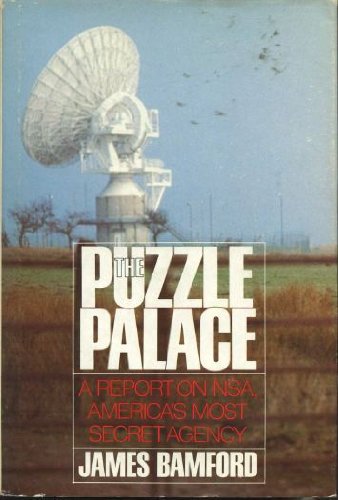
With the Ennes book having blazed a trail, other authors gradually followed. As an electronic surveillance platform, the Liberty operated under the auspices of the NSA, an organization then so secret that its employees sometimes joked that the initials stood for “No Such Agency.” In 1982, those shrouds of mystery were finally pierced when journalist James Bamford published The Puzzle Palace, presenting the agency’s history and activities, which soon became a national bestseller and launched him on a career as one of America’s premier authors on national security matters.
From the very first, the NSA had been absolutely certain that the Israeli attack on the Liberty was deliberate, and the death or grievous injury of so many of its communication technicians and other employees together with an American cover-up deeply rankled the top leadership. So Bamford’s book included more than a dozen pages on the Liberty incident, revealing some of the secret intelligence evidence that had demonstrated Israel’s clear intent.

Two years later in 1984, foreign policy writer Stephen Green published a highly-regarded analysis of Israeli-American relations entitled Taking Sides, which drew glowing praise from former Sen. William Fulbright, who had chaired the Foreign Affairs Committee, international legal scholar Richard Falk of Princeton, and former Undersecretary of State George Ball. Green devoted his penultimate chapter to the Liberty incident, effectively summarizing the facts across those 30 pages and strongly endorsing most of Ennes’ conclusions, while providing additional evidence that the attack was deliberate, some of it based upon newly declassified documents. He also pointed out that if the operation had succeeded and the Liberty had been sunk with no survivors, America might have easily blamed Egypt for the attack, with major geopolitical consequences. Since the ship’s survival was little short of a miracle, that might have been the primary motive.
I was just a young child in 1967, and never heard a word about the attack at the time nor for long afterward. Even once the Ennes book appeared a dozen years later, I don’t remember seeing anything about it, nor was I aware of the accounts contained in the specialized volumes by Bamford and Green that soon followed. At some point, I think I did vaguely hear something about an American ship that had been accidentally attacked by Israel during the 1960s, but that was probably the limit of my knowledge.
In 1991 the subject finally did get some national attention in the aftermath of America’s victorious Gulf War against Saddam Hussein, as President George H.W. Bush became embroiled in a political battle with the Israeli government over the expansion of their illegal Jewish settlements in the Occupied West Bank and Gaza.
At that time, the Evans & Novak column by conservatives Rowland Evans and Robert Novak was among the most widely syndicated and influential in America, running in many hundreds of newspapers, and with Novak also having a large presence on the weekly political television shows. Their November 6, 1991 column dropped a major bombshell, reporting that radio transmissions proved the Israeli pilots had been fully aware that they were attacking an American ship and despite their frantic protestations had been ordered to go ahead and sink the Liberty regardless. These communications had been intercepted and decrypted by the intelligence staff at our Beirut Embassy, and the shocking transcripts were immediately provided to our ambassador, Dwight Porter, a highly esteemed diplomat, who had finally broken his self-imposed silence after 24 years. Moreover, these same facts were also confirmed by an American-born Israeli military officer who had been present at IDF headquarters that day, and who said that all the commanders there were sure that the ship being attacked was American. This may have been the first time I learned the true details of the 1967 incident, probably from one of Novak’s many television appearances.
Pro-Israel elements of the media and their numerous activist supporters immediately launched a fierce counter-attack, spearheaded by former New York Times Executive Editor Abe Rosenthal, a fervent partisan of Israel, who denounced the Evans & Novak column as biased, misinterpreted, and fraudulent. When I read Novak’s memoirs last year, he described how Israel’s partisans had spent many years pressuring newspapers into dropping his column, which substantially reduced its reach as the years went by. The columnists were punished for crossing red-lines, their future influence diminished, and other journalists were given a powerful warning message against ever doing anything similar.
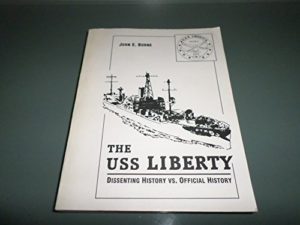
The USS Liberty: Dissenting History Vs. Official History
The story of the Liberty and especially the subsequent decades of political and media battles surrounding the case soon became the focus of scholarly research, with John E. Bourne making it the subject of his 1993 doctoral dissertation in history at NYU, then publishing the work through a small press two years later under the title The USS Liberty: Dissenting History Vs. Official History. Bourne’s coverage seemed meticulous and scrupulously fair, breaking little new ground but gathering together and conveniently referencing a great deal of the underlying information, including the surprising success of the Liberty survivors in getting their account of the attack into the public arena despite the overwhelmingly greater political and financial resources of their determined opponents.
One important point emphasized by Bourne is that while the version of events provided by the Liberty crewmen has been almost completely consistent and unchanging from the first day, the Israeli government and its partisans had promoted numerous contrary narratives, most of them mutually contradictory, with pro-Israel advocates making absolutely no effort to reconcile these, and instead merely ignoring such severe discrepancies. This surely relates to the fact that although there can only be one true account of a historical event, invented falsehoods may diverge in a wide variety of different directions.
A couple of years later in 1995, the front page of the New York Times broke a seemingly unrelated story, which certainly captured my attention at the time. Our national newspaper of record revealed that during both the 1956 and 1967 wars, the Israeli military had brutally massacred large numbers of Egyptian POWs, with the evidence coming from the detailed research of Israeli military historians, eyewitness testimony including that of a retired Israeli general, and the discovery of mass graves in the Sinai desert.
Then in 2001, James Bamford published Body of Secrets, a much longer and more detailed sequel to his earlier history of the NSA, which once again became a national bestseller. This time the author devoted one of his longest chapters entitled “Blood” entirely to the story of the Liberty, and provided many new revelations. Among other things, he suggested that the ship had been targeted for destruction because the Israeli leadership feared that its extensive electronic surveillance equipment might record evidence of the enormous war-crimes they had then been committing along the neighboring coast, now believed to involve the execution of some 1,000 helpless Egyptian captives and local civilians, certainly one of the largest such atrocities committed by any Western army since World War II. This now provided an additional possible motive for the seemingly inexplicable Israeli attack.Bamford’s book also contained an even more momentous disclosure. After 35 years of NSA silence, he revealed that the entire Liberty incident had been monitored in real-time by an American electronic spy plane cruising far overhead, which intercepted and rapidly translated all the radio communications between the attacking Israeli forces and their Tel Aviv controllers, information long regarded as “among NSA’s deepest secrets.” This helped explain why the senior leadership of the NSA had always been virtually unanimous that the attack was deliberate and intended to leave no survivors.
These intercepted conversations from the Israeli planes and torpedo boats had repeatedly mentioned seeing the Liberty‘s large American flag, putting the lie to decades of emphatic denials. In Washington, DC, the top leadership of the NSA had been outraged by this information, especially once they realized that the Johnson Administration intended to protect Israel from any embarrassment, and had even considered sinking the Liberty after the attack to prevent journalists from photographing the severe damage. Indeed, the Liberty was strangely ordered to sail to distant Malta rather than the much closer port in Crete, perhaps in hopes that the limping vessel with a large hole in its hull would sink along the way, thereby permanently hiding the visual evidence.
Bamford’s book also provided new information on the strange circumstances of the recall of two flights of carrier jets dispatched to rescue the Liberty during the attack, a development that had always been a source of puzzlement. The Liberty‘s senior intelligence officer revealed that he was later informed by the Sixth Fleet’s carrier admiral that the recall had been ordered by a direct phone call from Secretary of Defense Robert McNamara, with President Lyndon Johnson himself allegedly even getting on the line to demand that the order be obeyed and the Liberty left to its fate.
Bamford also noted that Israel’s brutal and unprovoked attack on the American ship was hardly inconsistent with that country’s other behavior. Not only had the Israelis been concurrently massacring so many hundreds of Egyptian POWs, but just a day or two earlier an Israeli tank column had attacked a convoy of unarmed UN peacekeepers flying their blue flag, brutally killing more than a dozen of them, while also blasting the local UN headquarters.
Bamford’s text ran more than 700 pages, with his discussion of the Liberty incident amounting to less than 10% of the total, but that chapter attracted a hugely disproportionate share of the press interest, with the New York Times even running a major news story on the important new evidence he provided. The book’s very favorable Times review also devoted quite a lot of space to his Liberty coverage, even though the reviewer strongly questioned the theory that the attack might have been motivated by Israel’s desire to conceal its concurrent war crimes. Although most such reviews were quite laudatory, the notoriously pro-Israel New Republic launched a fierce attack, authored by an American-born Israeli historian who had renounced his U.S. citizenship in order to enter Israeli government service, and I hardly considered it convincing at the time, even before I recently discovered Bamford’s very effective rebuttal.
Although I only read Bamford’s book itself a couple of years ago, I had seen the Times pieces and many of the other reviews when they originally appeared, and taken together all of this material further strengthened my conviction that the Liberty attack had been no accident.
Revealing the American Cover-Up After 40 Years
Up until this point, Israel’s partisans had mostly operated on defense, emphasizing the original verdict of accident issued by America’s official 1967 inquiry panel, while working to suppress the reach of books or articles that challenged this established position. Given this situation, Bourne’s thorough media research suggested that they probably believed that silence was the best strategy to follow. The longest piece actively promoting the accidental attack theory had been a 6,000 word article in the September 1984 issue of The Atlantic Monthly, possibly written in response to the Ennes or Green books. The two authors had been Israeli journalists who relied almost entirely upon Israeli sources, mostly official ones, and the piece was hardly likely to sway the growing number of skeptics.
But in 2002, A. Jay Cristol, a Jewish bankruptcy judge in Florida who had served nearly four decades in our naval reserves, released The Liberty Incident, arguing that the attack had been purely accidental. Cristol’s Preface emphasized his pro-Israel views and numerous Israeli friends, who encouraged and assisted this project, which he had begun some fifteen years earlier as an adult education masters thesis.
Although heavily promoted by Israel’s numerous partisans, who used the occasion to loudly declare “Case Closed,” I never heard of the book at the time, and was quite unimpressed when I recently read it, since it seemed to largely ignore or dismiss the mountain of evidence contrary to its thesis of Israeli innocence.
Indeed, the publication of Cristol’s book provoked a particularly important reaction. One of the individuals whom the author had favorably cited as “a man of integrity,” was retired Captain Ward Boston, Jr., the Navy attorney who had actually authored the official inquiry report in 1967. After having kept silent for nearly four decades, Boston was so outraged by Cristol’s analysis that he came forward and signed a legal affidavit revealing the true facts of the original investigation.
According to Boston, both he and his superior, Admiral Isaac C. Kidd, the presiding judge, had been absolutely convinced at the time that Israel had deliberately attacked the Liberty and murdered our sailors, but they had been ordered by their political and military superiors, including Admiral John S. McCain, Jr., father of the late senator, to absolve the Jewish State of any blame. Moreover, major elements of their written report were deleted or altered before release, in further efforts to conceal the clear evidence of Israel’s guilt. Considering that for over 35 years, Boston’s official handiwork had been cited as the primary bulwark supporting Israeli innocence, his signed January 9, 2004 affidavit constituted a very powerful declaration to the contrary. Aside from condemning Cristol as a fraud and a liar and reporting that Admiral Kidd believed the author “must be an Israeli agent,” Boston’s statement closed with the following paragraph:
Contrary to the misinformation presented by Cristol and others, it is important for the American people to know that it is clear that Israel is responsible for deliberately attacking an American ship and murdering American sailors, whose bereaved shipmates have lived with this egregious conclusion for many years.
A few years later, a major expose in the Chicago Tribune finally demolished the remaining shards of the decades-long cover-up. Written by a senior Tribune journalist who had previously won a Pulitzer Prize at the New York Times and drawing upon dozens of interviews and a large cache of official government documents newly declassified after four decades, the 5,400 word article was probably the longest piece on the Liberty incident ever to appear in the mainstream American news media. Much of the material presented was extremely damning, fully confirming crucial elements of previous accounts and demonstrating the extent of the ensuing cover-up.
Tony Hart, a former communications operator at a relay station remembers listening to the words of Secretary of Defense McNamara as he personally ordered the recall of the jets sent to rescue the Liberty: “President [Lyndon] Johnson is not going to go to war or embarrass an American ally over a few sailors.” This independently confirmed the account reported by a Liberty officer a few years earlier in Bamford’s book.
Aside from McNamara, nearly all the other senior members of the Johnson administration agreed with top intelligence advisor Clark Clifford that it was “inconceivable” that the attack had been a case of mistaken identity. NSA Director Lt. Gen. Marshall Carter later secretly testified to Congress that the attack “couldn’t be anything else but deliberate,” and numerous other former top national security officials provided similar statements to the Tribune, finally going on the record after forty years.
For decades, a crucial point of contention had been whether the Liberty was flying an American flag visible to the attacking Israeli forces. At the time, the Israeli court of inquiry had firmly declared that “Throughout the contact, no American or any other flag appeared on the ship.” As recently as 2003, the Jerusalem Post had interviewed the first Israeli pilot to attack, and he once again declared that he had circled the ship twice, slowing down and looking carefully, and “there was positively no flag.”
By contrast, declassified NSA documents stated that all the surviving crew members interviewed had uniformly agreed that their ship had been flying a large flag before, during, and after the attack, except for a brief period when it had been shot down, quickly replaced by their largest American flag, measuring 13 feet long.
NSA transcripts affirmed the claims of the Americans and proved that the Israelis were lying. As numerous sources had claimed over the years, the intercepted transmissions of the Israeli pilots had been immediately translated into English, with transcripts of their conversations rolling off the teletype machines at our intelligence offices around the world. These proved beyond any doubt that the pilots reported the ship was American and they had been ordered to sink it regardless, with the content of the transcripts confirmed by separate interviews with American intelligence specialists based in Nebraska, California, and Crete, while several other former American officials also confirmed the existence of those transcripts.
Five days later the Israeli Ambassador secretly warned his government that the Americans had “clear proof” that the attack had been deliberate. But according to a former CIA officer, the transcripts “were deep-sixed because the administration did not wish to embarrass the Israelis.” This official cover-up was partially circumvented by some shrewd intelligence officials who had those transcripts assigned for official training purposes at the U.S. Army’s intelligence school. W. Patrick Lang, who later spent eight years as Chief of Middle East intelligence for the DIA, vividly remembers seeing them in his coursework, and they left absolutely no doubt that the Israeli attack had been deliberate.
Although some tapes had been released, several of the personnel originally involved in recording and translating the transmissions agree that at least two of the key tapes have now gone missing or at least have not yet been declassified, and this is supported by gaps in the numbering of those that have been released.
• New revelations in attack on American spy ship by John Crewdson • The Chicago Tribune • October 2, 2007 • 5,400 Words
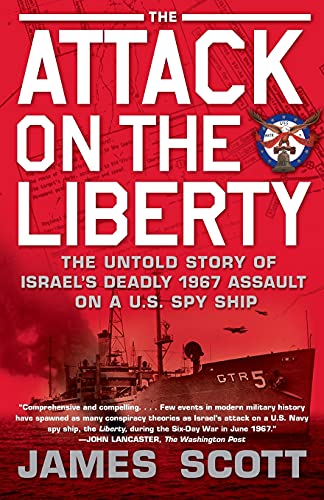
A couple of years later in 2009, James Scott, a young, award-winning journalist and son of a Liberty survivor, published Attack on the Liberty, a book that seemed likely to become the final major account of the incident. Released by a prestigious mainstream press, the text ran more than 350 pages with copious notes and numerous photographs. When I read it six or seven years ago, I didn’t think it broke much new ground, but the work seemed to very effectively summarize all of the main material from more than four decades of research and debate, probably becoming that standard text on the topic.
A great deal of information is also now easily available on the Internet. Alison Weir runs If Americans Knew, an activist organization focused on the Israel-Palestine conflict, and a section of her website provides a convenient repository of numerous primary source documents regarding the U.S.S. Liberty incident. A U.S.S. Liberty Memorial website also provides considerable material on the event.
In recent years, our own Philip Giraldi, a former CIA officer, has become one of the most regular writers on the story of the Liberty, producing half a dozen articles focused directly on that topic:
• Sinking Liberty
Who will write the final chapter on Israel’s 1967 confrontation with the U.S. Navy?
Philip Giraldi • The American Conservative • March 17, 2011 • 1,600 Words
• The USS Liberty Must Not be Forgotten
Forty-eight years is too long to wait for justice
Philip Giraldi • The Unz Review • June 9, 2015 • 1,200 Words
• Remembering the U.S.S. Liberty
The power of the Israel Lobby
Philip Giraldi • The Unz Review • June 14, 2016 • 1,600 Words
• Remembering the U.S.S. Liberty
The 50 year cover-up of a mass murder of U.S. servicemen orchestrated by Israel and its friends
Philip Giraldi • The Unz Review • June 6, 2017 • 1,600 Words
• The USS Liberty Wins One!
The American Legion finally calls for a congressional inquiry
Philip Giraldi • The Unz Review • September 5, 2017 • 2,300 Words
• Israel’s War Crimes Have Killed Americans
If the president loves to honor the military, start with the U.S.S. Liberty
Philip Giraldi • The Unz Review • May 5, 2020 • 2,300 Words
President Lyndon Johnson and a Planned Attack on Egypt?
Over the last few years my understanding of many major historical events has undergone a radical transformation, but the Liberty incident was not among them. Since I first encountered the story almost thirty years ago, my views had merely solidified rather than changed in any significant respect. I’d immediately been persuaded that the attack was intentional, soon followed by a disgraceful American cover-up, and the three or four books I eventually read on the topic had merely filled in some blanks, while casting my original conclusions into solid concrete. The only remaining mystery was the Israeli motive for such an apparently reckless undertaking, and with three or four somewhat plausible possibilities having been suggested, there seemed to be no way of deciding between them. Not only did I regard the topic as closed, but I believed it had been closed for at least a decade or two. And that was my settled opinion until a month ago.
The story of a deadly Israeli attack upon America’s own military and a long and shameful cover-up naturally provoked all sorts of wild speculation from conspiracy-minded individuals, who regularly expounded the most bizarre ideas on the comment-threads of any article discussing the topic. A couple of years ago, I noticed a flurry of such chatter, including claims of a diabolical plot by President Johnson to treacherously arrange the attack on his own ship as an excuse for starting World War III, with the theory having apparently been promoted by some recently published book.
At first I paid no attention to such nonsense, but I eventually took a look at the Amazon page of Blood in the Water by Joan Mellen, an author entirely unknown to me, and was shocked to discover lavish praise by Prof. Richard Falk of Princeton, an eminent international legal scholar. Thinking that the theory might be less absurd than it seemed, I clicked a button, bought it, and suspended my disbelief during the two days it took me to read the text.
Unfortunately, the contents were almost exactly as I had originally assumed, filled with implausible speculations, unwarranted assertions, and huge leaps of logic. Unsubstantiated claims were endlessly repeated, apparently in hopes of bludgeoning the reader into eventual acceptance. And although the text was purportedly written by a tenured professor of English at a small university, the editing was among the worst of any professionally-published book I had ever encountered, with the same sentence—or even the same short paragraph—sometimes duplicated on consecutive pages; such severe stylistic flaws merely deepened my skepticism about the credibility of the substantive material presented. Prof. Falk was an esteemed scholar, but he had also been in his late 80s when the book was released, and I assumed that he hadn’t actually read the text apart from a few small extracts, while his outrage at a half-century of governmental injustice had secured his endorsement of such a poor quality expose. I felt that my time reading it had been wasted, and I became more firmly convinced than ever that the story of the Liberty was closed.
Then earlier this year I once more began seeing some chatter about a very similar theory regarding the Liberty, again advanced by an author totally unknown to me and presented in a book bearing an especially lurid title. I naturally dismissed such nonsense under the principle of “once bitten, twice shy.”
However, a month or two ago, I happened to be reading a work by Michael Collins Piper, a conspiracy-researcher who had earned my considerable respect, and in a couple of sentences he alluded to the book in question, greatly praising its “astonishing” findings. So I looked it up on Amazon and found that it had been released in 2003. A book published 18 years ago by a tiny press that made such wild charges but had never attracted any attention nor reviews was hardly likely to be very persuasive, but since I had some time on my hands, I ordered a copy and a few days later took a look.
I had never heard of Peter Hounam and a book entitled Operation Cyanide containing wild talk of World War III in the subtitle certainly multiplied my doubts, but the cover carried a glowing endorsement by the BBC World Affairs Editor, hardly the sort of individual likely to lend his name to crackpots. Moreover, according to the back flap, Hounam had spent thirty years in mainstream British journalism, including a long stint as Chief Investigative Journalist at the London Sunday Times, so he obviously possessed serious credentials.
A bit of casual Googling confirmed these facts and also revealed that in 1987 Hounam had led the Sunday Times team that broke the huge story of Israel’s nuclear weapons program, with the evidence provided by Israeli technician Mordechai Vanunu, just before he was kidnapped by Mossad, returned to Israel, and given a twenty year prison sentence. Hounam certainly had a much more impressive background than I had initially assumed.
The book itself was of moderate length, running perhaps 100,000 words, but quite professionally written. The author carefully distinguished between solid evidence and cautious speculation, while also weighing the credibility of the various individuals whom he had interviewed and the other material used to support his conclusions. He drew upon most of the same earlier sources with which I was already familiar, as well as a few others that were new to me, generally explaining how he reached his conclusions and why. The overall text struck me as having exactly the sort of solid workmanship that one might expect from someone who had spent three decades in British investigative journalism, including a position near the top of the profession.
As Hounam explained on the first page, he had been approached in 2000 by a British television producer, who recruited him for a project to uncover the truth of the attack on the Liberty, an incident then entirely unfamiliar to him. His research of the history occupied the next two years, and included travels throughout the United States and Israel to interview numerous key figures. The result was an hour-long BBC documentary Dead in the Water, eventually shown on British television, as well as the book he concurrently produced based upon all the research he had collected.
As I began the text, the first pages of the Introduction immediately captured my attention. In late 2002, with the book almost completed, Hounam was contacted by Jim Nanjo, a 65-year-old retired American pilot with an interesting story to tell. During the mid-1960s he had served in a squadron of strategic nuclear bombers based in California, always on alert for the command to attack the USSR in the event of war. On three separate occasions during that period, he and the other pilots had been scrambled into their cockpits on a full-war alert rather than a training exercise, sitting in the planes for hours while awaiting the signal to launch their nuclear attack. Each time, they only discovered the event that had triggered the red alert after they received the stand-down order and walked back to their base. Once it had been the JFK assassination and another time the North Korean seizure of the U.S.S. Pueblo, with the third incident being the 1967 attack upon the Liberty.
All of this made perfect sense, but when Hounam checked the pilot’s reported chronology, he discovered that the squadron had actually been put on full war-alert status at least an hour before the Liberty came under Israeli attack, an astonishing logical inconsistency if correct.
Memories may easily grow faulty after 35 years, but this strange anomaly was merely one of many that Hounam encountered during his exhaustive investigation and the facts that he uncovered gradually resolved themselves into the outline of a radically different reconstruction of historical events. Although more than half the book recounts the standard elements of the Liberty story that I had already read many times before, the other material was entirely new to me, never mentioned elsewhere.
President Johnson was a notorious micro-manager, very closely monitoring daily casualties in Vietnam, as well as the sudden new outbreak of war in the Middle East, and he always demanded to be told immediately of any important development. Yet when America’s most advanced spy ship with a crew of nearly 300 reported that it was under deadly attack by unknown enemy forces, he seems never to have been informed, at least according to the official White House logs. Instead, he supposedly spent the morning casually eating his favorite breakfast and then mostly engaging in domestic political chit-chat with various senators.
Declassified documents from the CIA, the NSA, and the Pentagon prove that red-alert messages had been sent to the White House Situation Room almost immediately, and American military policy is that any flash message reporting an attack on a U.S. naval vessel must be immediately passed to the president, even if he is asleep. Yet according to the official records, Johnson—wide awake and alert—received no notice until almost two hours later, after the assault on the Liberty had ended. Moreover, even when finally informed, he seemed to pay little attention to the most serious naval attack our country had suffered since World War II, instead focusing upon minor domestic political issues. Johnson did put in two calls to Secretary of Defense Robert McNamara, who according to naval logs minutes later ordered the recall of the carrier planes sent to rescue the Liberty, and Secretary of State Dean Rusk later stated that McNamara would never have made that decision without first discussing it with his president. But based upon the official records Johnson himself had not yet been informed that any attack had occurred.
Indeed, according to the later recollections of Rusk and top intelligence advisor Clark Clifford, during the morning Situation Room meeting two hours later, the Soviets were still believed responsible for the attack, and the participants had a sense that war might have already broken out. Although the Israeli identity of the attackers had been known for more than an hour, most of our top government leaders still seemed to be contemplating World War III with the USSR.
Hounam believes that these numerous, glaring discrepancies indicated the official logs had been altered in potentially very serious ways, apparently with the intent of insulating President Johnson from having learned of the attack and its crucial details until long after that had occurred. The author’s analysis of these severe chronological discrepancies seems quite meticulous to me, covering several pages, and should be carefully read by anyone interested in these highly suspicious events and the seemingly doctored record.
Hounam also focused upon several unexplained elements presented in the books by Ennes and others. There does seem solid if very fragmentary evidence that the Liberty‘s positioning off the Egyptian coast was part of some broader American strategic plan, whose still classified details remain largely obscure to us. Ennes’ book briefly mentioned that an American submarine had secretly joined the Liberty as it traveled to its destination, and had actually been present throughout the entire attack, with some of the sailors seeing its periscope. Although one of the crew had been privy to the classified details, he later refused to divulge them to Ennes when asked. According to some accounts, the sub had even used a periscope camera to take photographs of the attack, which various individuals later claimed to have seen. The official name for that secret submarine project was “Operation Cyanide,” which Hounam used for the title of his book. One heavily-redacted government document obtained by Hounam provides tantalizing clues as to why the Liberty had officially been sent to the coast, but anything more than that is speculation.
There were other strange anomalies. A senior NSA official had been strongly opposed to sending the Liberty into a potentially dangerous war-zone but had been overruled, while the ship’s request for a destroyer escort from the Sixth Fleet had been summarily refused. The day before the attack, top NSA and Pentagon officials had recognized the obvious peril to the ship, even receiving a CIA intelligence report that the Israelis planned to attack, and this led to several urgent messages being sent from Washington, ordering the captain to withdraw to a safe distance 100 miles from the coast; but through a bizarre and inexplicable series of repeated routing errors, none of those messages had ever been received. All of these seemingly coincidental decisions and mistakes had ensured that the Liberty was alone and defenseless in a highly vulnerable location, and that it remained there until the Israeli attack finally came.
Hounam also sketched out the broader geopolitical context to the events he described. Although originally open to friendly relations with America, Egyptian leader Gamal Nasser had been denied promised US assistance due to the pressure of our powerful Israel Lobby and was therefore pushed into the arms of the USSR, becoming a key regional ally, arming his military forces with Soviet weaponry and even allowing nuclear-capable Soviet strategic bombers to be based on his territory. As a consequence, Johnson became intensely hostile towards Nasser, regarding him as “another Castro” and seeking the overthrow of his regime. This was one of the major reasons his administration offered a green-light to Israel’s decision to launch the Six Day War.
In the opening hours of that conflict, Israel’s surprise attack had destroyed the bulk of the Egyptian and Syrian air forces on the ground, and these devastating losses soon led Nasser and other Arab leaders to publicly accuse the American military of having entered the war on Israel’s side, charges almost universally dismissed as ridiculous both by journalists at the time and by later historians. But Hounam’s detailed investigation uncovered considerable evidence that that Nasser’s claims may have been true, at least with regard to aerial reconnaissance and electronic communications.
According to the statements of former American airman Greg Reight, he and his aerial photo reconnaissance unit were secretly deployed to Israel, assisting the attack by determining enemy losses and helping to select subsequent targets. This personal account closely matched the details of the overall operation previously described in Green’s book almost two decades earlier. All these claims were supported by the extremely sharp photos of destroyed Egyptian airfields later released by Israel and published in American news magazines since experts agreed that the Israeli air force did not then possess any of the necessary camera equipment.
A successful Florida businessman named Joe Sorrels provided a very detailed account of how his American intelligence unit had been infiltrated into Egypt’s Sinai Peninsula before hostilities began and set up electronic monitoring and “spoofing” equipment, which may have played a crucial strategic role in enabling the sweeping Israeli victory. There were even claims that American electronic expertise helped locate the crucial gaps in the radar defenses of the Egyptian airfields that allowed Israel’s surprise attack to become so successful.
Hounam also emphasized the likely political motive behind Johnson’s possible decision to directly back Israel. By 1967 the Vietnam War was going badly, with mounting American losses and no victory in sight, and if this quagmire continued, the president’s reelection the following year might become very difficult. But if the Soviets suffered a humiliating setback in the Middle East, with their Egyptian and Syrian allies crushed by Israel, perhaps culminating in Nasser’s overthrow, that success might compensate for the problems in Southeast Asia, diverting public attention toward much more positive developments in a different region. Moreover, the influential Jewish groups that had once been among Johnson’s strongest supporters had lately become leading critics of the continuing Vietnam conflict; but since they were intensely pro-Israel, success in the Middle East might bring them back into the fold.
This provides the background for one of Hounam’s most controversial suggestions. He notes that in 1964, Johnson had persuaded Congress to pass the Tonkin Gulf Resolution by a near-unanimous vote, authorizing military strikes against North Vietnam, but based upon an alleged attack upon American destroyers that most historians now agree was fictional. Although the resulting Vietnam War eventually became highly unpopular, Johnson’s initial “retaliatory” airstrikes just three months before the 1964 election rallied the country around him and helped ensure his huge landslide reelection victory against Sen. Barry Goldwater. And according to Ephraim Evren, a top Israeli diplomat in the U.S., just a few days before the outbreak of the Six Day War Johnson met with him privately and emphasized the urgent need “to get Congress to pass another Tonkin resolution,” but this time with regard to the Middle East. An excuse for direct, successful American military intervention on Israel’s behalf would obviously have solved many of Johnson’s existing political problems, greatly boosting his otherwise difficult reelection prospects the following year.
We must always keep in mind that only a miracle kept the Liberty afloat, and if it had been sunk without survivors as expected, almost no one in American media or government would have dared accuse Israel of such an irrational act. Instead, as Stephen Green had first suggested in 1984, Egyptian forces would very likely have been blamed, producing powerful demands for immediate American retaliation, but probably on a vastly greater scale than the fictional Tonkin Gulf attack, which had inflicted no injuries.
Indeed, Hounam’s detailed investigation discovered strong evidence that a powerful American “retaliatory” strike against Egypt had already been put into motion from almost the moment that the Liberty was first attacked. Paul Nes then served as charge d’Affaires at the U.S. Embassy in Cairo, and in a taped interview he recalled receiving an urgent flash message alerting him that the Liberty had been attacked, presumably by Egyptian planes, and that bombers from an American carrier were already on their way to strike Cairo in retaliation. With an American-Egyptian war about to break out, Nes and his subordinates immediately began destroying all their important documents. But not long afterward, another flash message arrived, identifying the attackers as Israeli and saying that the air strike had been called off. According to some accounts, the American warplanes were just minutes from Egypt’s capital city when they were recalled.
Let us consider this. In a taped interview a former top American diplomat revealed that in 1967 America came very close—perhaps even within minutes—of attacking Egypt in retaliation for the Liberty. Surely a revelation of this magnitude from such a credible source might be expected to reach the front page of the New York Times and other leading world newspapers. But instead I had never heard a word about it during the past 18 years, and a little Googling suggests that it has received virtually no discussion anywhere, except within the most obscure fringes of the Internet.
Most of this seems like very solid factual material, and although the resulting interpretations may differ, I think the hypothesis advanced by Hounam is quite plausible. He suggested that President Johnson helped arrange the attack on the Liberty, hoping to orchestrate a new Tonkin Gulf Resolution but on a much grander scale, allowing him to attack and oust Nasser in retaliation. An American military assault against such an important regional Soviet ally would certainly have raised the risk of a much broader conflict, so our strategic bomber force had been put on full war-alert an hour or more before the Liberty incident unfolded. However, the Liberty and its crew of eyewitnesses somehow managed to stay afloat and survive, and eventually word that their attackers had been Israeli rather than Egyptian reached our top political and military leadership ranks, so the plan had to be abandoned.
Our mainstream media has spent decades scrupulously avoiding the slightest hint that the attack on the Liberty had been part of a broader plot to unseat Nasser, one that probably involved President Johnson. But as the testimony of several eyewitnesses above indicates, many of these facts would have been known at least to the circle of military men and intelligence operatives involved in the project. So we should not be entirely surprised that elements of the story gradually leaked out, though often in garbled, inaccurate, and disjointed fashion.
Indeed, the first substantial account claiming that the Liberty attack had been intentional rather than accidental appeared in the writings of independent journalist Anthony Pearson, who in 1976 published a couple of long articles in Penthouse, allegedly based upon British intelligence sources, and he later incorporated these into his 1978 book Conspiracy of Silence. His account lacked any references, was written in a breathlessly conspiratorial fashion, and contained a number of glaring errors, so it was hardly reliable and usually dismissed. But it did seem to also contain a good deal of material that was only later confirmed by more reliable research, demonstrating that he had access to some knowledgeable individuals. And in his account, Pearson claimed that the attack had been part of a much broader American plan to overthrow Nasser, which suggests such rumors were circulating among his sources.
Bourne’s very thorough research mentioned that similar claims suggesting that the Liberty fell victim to an American-Israeli plan to bring down Nasser had also appeared in two books on intelligence matters published in 1980, Richard Deacon’s The Israeli Secret Service and Stewart Steven’s The Spymasters of Israel. These accounts similarly provided no sources and since they appeared too early to make use of Ennes’ detailed narrative, contained numerous factual errors, but they do further suggest that such theories, whether correct or not, had become quite widespread within intelligence circles.
A Nuclear Strike Against Egypt?
If this were the extent of the historical hypothesis advanced in Hounam’s relatively short book, his work would certainly rank as a remarkable piece of investigative journalism, possibly overturning decades of assumptions about the Liberty incident, and perhaps uncovering one of the most shocking examples of government treachery in American history. But there are additional elements, and although they are far less solidly established, they should not be ignored.
Recollections can easily fade over more than three decades, but some memories remain indelible. Hounam provides a great deal of testimony indicating that the bombers dispatched to strike Egypt in retaliation for its assumed attack on the Liberty may have been armed with nuclear warheads.
Mike Ratigan, a catapult operator on board the U.S.S. America, recalls that his entire ship was put into “Condition November,” a top alert status only used in connection with armed nuclear warheads, and that the special bombs being loaded onto the A-4 Skyhawk bombers were unlike any he had previously seen, while also being escorted by Marine guards, another very unusual situation. There was a widespread belief on the ship that a nuclear attack was about to be launched. For obvious reasons, the Navy had absolute rules that bombers carrying armed nuclear warheads were prohibited from landing on carriers, and after the flight was dispatched and then recalled, the planes were all diverted to a land airbase to be off-loaded, not returning to their carrier for four or five days.
That same carrier had been hosting 28 journalists from British and American media outlets, and some of these individuals also had strong recollections. Jay Goralski, a U.S. reporter, remembered that the bombers were launched in a retaliatory strike against shore targets and that they were only recalled and the strike aborted “at the last moment, just before they would have lost radio contact.” A UPI reporter named Harry Stathos saw the nuclear-armed aircraft being launched, and was told by the deck crew that the strike was targeting Cairo, though he agreed at the time not to disclose any of this information.
Liberty survivor Chuck Rowley later spoke to a carrier pilot who claimed he had flown one of the jets that day, saying he had been carrying nuclear weapons and had been ordered to target Cairo. Other Liberty survivors heard similar stories over the years from naval personnel who described the special alert status that day, as nuclear warheads were armed and loaded onto the bombers preparing to launch. Moe Shafer had been transferred to the Sixth Fleet flagship for treatment of his injuries, and he claimed that the commanding admiral mentioned to him that several of his bombers had been three minutes away from a nuclear attack on Cairo when they were recalled.
Joe Meadors, another former Liberty crewman, later heard from military personnel on Crete their astonishment at having to unload the armed nuclear warheads of bombers that had been diverted there rather than allowed to directly return to the carrier, and they were told that the planes had been sent to strike Cairo in retaliation for the Liberty.
All of this evidence is merely circumstantial, with much of it amounting to hearsay, often reported second or third hand by ordinary servicemen rather than by trained journalists or researchers. But there does seem to be quite a lot of it. Hounam remains somewhat agnostic about whether Cairo had indeed been targeted for a nuclear attack in retaliation for the Liberty, but he does not believe that the possibility can be entirely disregarded.
We must also keep in mind that a nuclear strike against Cairo would not necessarily mean the destruction of the densely populated urban center. The author notes that a squadron of nuclear-capable Soviet strategic bombers were based at a West Cairo airfield far from the urban core, and their presence in the Middle East had aroused great American concerns. He speculates that their destruction in a nuclear attack might have been seen as a very potent demonstration of supreme American power across the entire region but without inflicting the massive casualties of a bombing closer to the center of the city. Admittedly, all of this is pure conjecture, and until additional documents are declassified and made available, we lack the necessary means of forming any solid conclusions.
It is a truism that extraordinary claims require extraordinary evidence, and while the hypothesis that America in 1967 came very close to launching a nuclear attack against Nasser’s Egypt certainly falls into the former category, the evidence that Hounam has accumulated does not come close to meeting the requirements of the latter. However, while a month ago I would have regarded such a theory as utterly preposterous lunacy, not warranting a moment’s thought, I now view it as a serious possibility worth considering.
The absolute and total blackout that seems to have immediately enveloped Hounam’s remarkable book hardly increased the likelihood that many new sources would come forward, but the accompanying BBC documentary Dead in the Water was released and aired, becoming the first and only professional media treatment of that important historical episode.
As was appropriate, the bulk of the film covered the basic elements of the Liberty story, though including the suggestion that the motive of the Israeli action had been to provoke an American attack against Egypt and even raising the possibility that the use of nuclear weapons might have been planned. However, any speculation that President Johnson had been involved in the plot was left on the cutting-room floor, and perhaps this was the correct decision to make. The first serious documentary on a highly controversial but almost ignored historical event should probably stick close to the basics and not overly challenge its previously uninformed audience.
Although the documentary was never broadcast on American television, the rights were eventually transferred to the Liberty Veterans Association, which for many years sold the videocassette. A version of adequate quality is now available on Youtube, so those interested in the story of the Liberty may watch it and decide for themselves.
[embedyt] https://www.youtube.com/watch?v=3PDK4Ev-h8U[/embedyt]There is also an intriguing backstory both to Hounam’s book and to the British documentary that had originally brought the author into the topic. The entire project apparently came about through the efforts of Richard Thompson, a former American Intelligence officer, who later became a highly successful international businessman. For years he had been a determined champion of the Liberty issue and the surviving crew members, and he organized and funded the film project, investing a total of $700,000 of his own money to bring it to fruition. After the documentary was complete, Jewish groups in Britain went to court to block its release, forcing Thompson to spend $200,000 in legal fees to overcome their challenge and allow the broadcast. And although Thompson’s name is not listed on the cover of the accompanying book, he seems to have played a major role in providing some of the underlying research and he shared the copyright with Hounam.
Thompson had regularly attended annual Liberty reunions, and at the 40th in 2007, he arranged to meet with Mark Glenn, a journalist for American Free Press, an alternative tabloid newsweekly, known for its willingness to cover controversial issues, including those portraying Israel in a negative light. Thompson claimed to have important new information about the backstory to the Liberty incident, facts that further extended Hounam’s findings, and he promised to provide the material to Glenn in a series of interviews. However, while driving home from Washington the following morning, Thompson died in a strange one-car accident, as his vehicle crossed the dividing meridian of the interstate highway and collided with a tree. Although aged 76, Thompson had seemed in perfect health and he had previously reported being stalked by individuals apparently connected to Israel, so Glenn found his death suspicious, as did Michael Collins Piper, a noted conspiracy-researcher. More of Thompson’s background was provided in a fairly lengthy obituary that appeared in the Washington Report on Middle East Affairs, a well-regarded and somewhat establishmentarian publication critical of Israel.
This possibly suspicious death was not the only one associated with the Liberty issue. Anthony Pearson’s articles in Penthouse and his subsequent book had been the first to claim that the Israeli attack was deliberate, and a few years later he began to complain of persecution by the Mossad; soon afterwards, he was dead, allegedly having been poisoned. Bourne’s research reported that a rather dubious individual involved in numerous unsuccessful attempts during the mid-1980s to raise funding for a film on the Liberty was found shot to death in his Pasadena home in 1988, though the motive for the unsolved homicide may have been entirely unconnected.
Means, Motive, and Opportunity
The especially controversial elements of the theories propounded in Hounam’s 2003 book probably precluded any discussion by most others writing on the Liberty incident, which is why the work never came to my attention until quite recently. In his comprehensive 2009 book, Scott thanked Thompson for having provided him with numerous out-takes from his Dead in the Water documentary, but neither Thompson’s name nor that of Hounam appeared anywhere else in the text, perhaps because such a reference might have alarmed the very mainstream publisher, Simon and Schuster. Hounam’s name also is nowhere to be found on Alison Weir’s website nor that of the U.S.S. Liberty memorial organization. Even individuals who had published several articles on the Liberty were completely unfamiliar with Hounam’s ground-breaking research when I queried them.
However during the last few years, this situation has begun to change. Mellen’s 2018 book had developed a theory quite similar to the one that Hounam had published fifteen years earlier, and she repeatedly referenced him. As I now reread her work, all the severe flaws I had previously noticed were still just as apparent, but I also recognized that she did provide a considerable amount of additional useful information, supplementing Hounam.
The previous year had been the 50th anniversary of the Liberty incident and noted conspiracy researcher Phillip F. Nelson had marked the occasion by releasing a far stronger book on the incident. The author fully acknowledged that he was closely following the trail blazed by Hounam, whose work he repeatedly characterized as “seminal.” Remember the Liberty! was written in association with several of the Liberty survivors and included a Foreword by highly-regarded former CIA analyst Ray McGovern.
Nelson was an especially harsh critic of Lyndon Johnson, probably best known for his 2010 and 2014 books marshaling the considerable evidence implicating LBJ in the assassination of his predecessor John F. Kennedy, and at certain points he seemed insufficiently cautious about accepting some of less solidly-attested accusations in the case of the Liberty. But the author does provide a great deal of important information on the president’s very difficult political situation in 1967, persuasively extending Hounam’s argument that a new Tonkin Gulf type event in the Middle East and a sweeping American military victory might have been crucial to Johnson’s prospects for reelection in 1968.
During the three generations since World War II, America has ranked as the world’s leading superpower, with its military possessing unmatched global reach and strength. Although the Liberty was a nearly defenseless intelligence ship sailing international waters, our powerful Sixth Fleet was nearby, so the deadly attack upon the vessel was not merely an obvious war-crime, but a very strange one, perhaps the most serious that our forces had suffered in decades, yet still entirely unpunished even today.
Solving such a crime usually involves a careful consideration of means, motive, and opportunity. There is no doubt that Israel’s military deliberately attacked our ship, but the other two legs of the tripod remain puzzling. The risks that Israel took in its unprovoked attack against the ship of its sole ally were enormous. And the opportunity to sink the Liberty only came about due to a long and very strange series of supposed American communication errors. But if we accept the framework proposed by Hounam, Nelson, Mellen, and their adherents and postulate the secret involvement of President Lyndon Johnson, both these difficulties immediately disappear.
Planning to sacrifice a few hundred American lives and risk World War III to bolster his reelection chances would obviously add a very black mark to the reputation of our 36th president. But based upon my extensive historical research, I do not think he would have been the first American leader to have followed this sort of callous political calculus, although such decisions were afterward concealed by later generations of historians. Indeed, a couple of years ago, I came to very similar conclusions regarding the primary architect behind the outbreak of World War II:
During the 1930s, John T. Flynn was one of America’s most influential progressive journalists, and although he had begun as a strong supporter of Roosevelt and his New Deal, he gradually became a sharp critic, concluding that FDR’s various governmental schemes had failed to revive the American economy. Then in 1937 a new economic collapse spiked unemployment back to the same levels as when the president had first entered office, confirming Flynn in his harsh verdict. And as I wrote last year:
Indeed, Flynn alleges that by late 1937, FDR had turned towards an aggressive foreign policy aimed at involving the country in a major foreign war, primarily because he believed that this was the only route out of his desperate economic and political box, a stratagem not unknown among national leaders throughout history. In his January 5, 1938 New Republic column, he alerted his disbelieving readers to the looming prospect of a large naval military build-up and warfare on the horizon after a top Roosevelt adviser had privately boasted to him that a large bout of “military Keynesianism” and a major war would cure the country’s seemingly insurmountable economic problems. At that time, war with Japan, possibly over Latin American interests, seemed the intended goal, but developing events in Europe soon persuaded FDR that fomenting a general war against Germany was the best course of action. Memoirs and other historical documents obtained by later researchers seem to generally support Flynn’s accusations by indicating that Roosevelt ordered his diplomats to exert enormous pressure upon both the British and Polish governments to avoid any negotiated settlement with Germany, thereby leading to the outbreak of World War II in 1939.
The last point is an important one since the confidential opinions of those closest to important historical events should be accorded considerable evidentiary weight. In a recent article John Wear mustered the numerous contemporaneous assessments that implicated FDR as a pivotal figure in orchestrating the world war by his constant pressure upon the British political leadership, a policy that he privately even admitted could mean his impeachment if revealed. Among other testimony, we have the statements of the Polish and British ambassadors to Washington and the American ambassador to London, who also passed along the concurring opinion of Prime Minister Chamberlain himself. Indeed, the German capture and publication of secret Polish diplomatic documents in 1939 had already revealed much of this information, and William Henry Chamberlin confirmed their authenticity in his 1950 book. But since the mainstream media never reported any of this information, these facts remain little known even today.
Postscript: Someone brought to my attention an outstanding four-part documentary series on the story of the Liberty directed by Matthew Skow that was released last year, based upon extensive interviews with the surviving crew members and having very high production values. The overall feature runs nearly five hours, with the last segment focusing primarily on the controversial issues raised in Hounam’s book. It’s available for purchase or rent, and I’d highly recommend it.
• Sacrificing Liberty
A Four Episode Docuseries
Matthew Skow • TruHistory Films • 2000 • 4 hours 44 minutes
“The true story of the USS Liberty is more shocking than any spy novel written by Tom Clancy. The most top-secret spy ship in the world. Its client was the NSA. The ship and its 294 U.S. Navy sailors were rushed to the Mediterranean Sea. Only the White House and Pentagon knew that Israel was ready to attack Arab nations. The USS Liberty was deliberately sent into a kill zone. The casualties were staggering: 34 killed and 174 wounded. The coverup began immediately and has continued since 1967. Until now! The aging survivors have finally told their true story. Sacrificing Liberty sets the record straight.”
